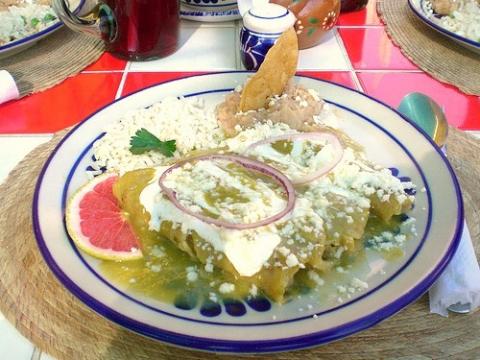Submitted by Emilio Castellanos on

Description
From Rick Bayless: "Here is a recipe for the classic Mexican enchiladas, the ones that combine a flavor that is traditionally tart and piquant with the mealy meatiness of corn tortillas, the tenderness of chicken and a sharp, salty adornment of aged Mexican cheese. They’re rolled up and sauced in cafeterías (especially the new, bright chain restaurants) everywhere—and with above-average fervor in the heartland sections of Central and West-Central Mexico. They’re simple to make, easy to enjoy and attractively filling.
Ingredients
Instructions
For the Salsa Verde click here http://www.yantus.com/sauces/tomatillo-sauce-II
1. The sauce and the filling: Heat the tomatillo sauce in a small, covered pan over low. Warm up the chicken in a separate pan over low heat (sprinkled with a little water so it won’t dry out), then stir in the cream or sour cream, onion and salt; set aside off the fire, covered.
2. The tortillas: If the tortillas are moist, let them dry out for a few minutes in a single layer. Heat the oil in a small skillet over medium-high. When sizzlingly hot, quick-fry the tortillas to soften them, one at a time, for 2 to 3 seconds on each side. Drain on paper towels.
3. Assembling the enchiladas: About 20 minutes before serving, preheat the oven to 350°. Pour a cup of the warm sauce into a plate. Lay a tortilla in the sauce, flip it over, lay a scant 2 tablespoons of the filling across the center and roll it up (fingertips are most efficient here). Transfer to a baking dish, then continue filling and rolling the rest of the tortillas. Pour the remaining sauce over the enchiladas, being careful to cover the ends.
4. Baking: Immediately cover the dish with foil and bake just long enough to heat through, about 10 minutes. Sprinkle the enchiladas with the crumbled cheese, decorate with onion rings and radishes, and serve right away.
Traditional Variations
Enchiladas Suizas: Prepare the recipe as directed, adding 1 cup Thick Cream or whipping cream to the tomatillo sauce. Top the enchiladas with 6 ounces (1½ cups) grated melting cheese like mild cheddar or Monterey Jack (see Notes) and bake 10 minutes uncovered at 400°. Omit the other garnishes.
Seafood Enchiladas: In the northwest, they frequently replace the chicken with 1¼ cups flaked, poached, boneless fish (like sea bass, halibut, cod—even chopped shrimp or shredded crab). Complete the recipe as directed.
Traditional North American Variations
Cheese Enchiladas: Use 1 pound grated mild cheddar or Monterey Jack in place of the chicken filling (grated onion may be added, but no cream). Complete the recipe as directed, baking the enchiladas until the cheese melts. A little cheese may be sprinkled on the enchiladas before baking.
Notes
Timing and Advance Preparation
With the tomatillo sauce and chicken on hand, the enchiladas can be ready in about ½ hour. Though not really sanctioned, these enchiladas can be partially made ahead: Quickfry the tortillas, but don’t dip them in the sauce; fill and roll them, then cover and refrigerate; bring to room temperature, cover with foil and bake 10 minutes at 350°; cover with hot sauce and bake 5 minutes longer, then garnish and serve.
Ingredients:
Fresh or Aged Crumbling Cheese (Queso Fresco/Queso Anejo): In Mexico, this white cheese is available in nearly all markets; it ranges in size from huge blocks to tiny cakes, and in texture from fine (almost smooth on the tongue) to coarse and spongy; all of it breaks apart or crumbles readily when pressed between the fingers (like the dry fresh farmer’s cheese). Most of it softens when heated (often exuding whey), but it usually will not melt. Most is made from skimmed (usually unpasteurized) milk, is sold within a day or two of making (so it is often still draining whey), and has a high water content (so it may spoil if not stored properly). Some versions are specially made for aging (they seem to dehydrate more than ripen, perhaps because of the high salt content). Most Mexican fresh cheeses taste fresh and milky (rather than cheesy) and they have a good amount of acid and salt. An aged cheese retains some of that milkiness (though it’s sharper) and it doesn’t have the nutty, developed-cheese flavor of a Parmesan—a cheese you’d think it would resemble. Other names for queso fresco are simply queso, queso ranchero (“ranch Cheese”), and, occasionally, queso de metate (if its curds Have been smoothed on the metate); names for queso anejo include queso Cotija, queso oreado (literally “aired cheese”), and queso (“dry cheese”), plus the more distinct varieties like sierra and morral, which fill the same function.
In the United States, the queso fresco available from most of the cheese companies that specialize in Mexican cheese (Cacique and Supremo, among others) often tastes cheesy (like a Muenster) or bland; the only exception I can recommend is the 5-ounce round of “queso fresco/Mexican-style cheese” made by Supremo in Chicago. When that’s not available, I usually use the creamier feta cheese to replace either queso fresco or queso añejo, though it is more strongly flavored. To tame its brininess, soak it in water for an hour or two; to give it a more authentic texture, let it dry out at room temperature, turning occasionally, for a day or two. Some other substitutes for queso fresco are: dry (pressed), fresh farmer’s cheese, usually available in pear-shaped slabs (this doesn’t have the acidity or saltiness of queso fresco; crumble and add salt); dry-curd cottage cheese (this has a high moisture content, so press it between paper towels, then crumble and add salt); a mild, domestic, fresh goat cheese, like the small rounds made in California, New York or New Jersey (these are tangier and creamier than queso fresco, but they have a similar fresh quality). In addition to feta, some other substitutes for queso añejo are: a mild Parmesan, Romano or-Sardo (they all lack that milkiness and are more cheesy-flavored, though they can be crumbled/grated appropriately) or the dry ricotta (not the soft variety packed in tubs) available in some specialty cheese stores (look for salted ricottal ricotta salata or aged ricotta).
Notes
Yantus' notes:
To make the filling and fill the tortillas: Once you have the chicken on a dish, add chopped onion, 1/4 of a cup of the Mexican cream, and about 1/2 a cup of the tomatillo sauce to moisten the chicken filling. Mix well. Heat a large non-stick frying pan. Pour some olive oil on one small plate and with your hand rub the olive oil on both sides of each tortilla, then place the tortillas on the frying pan until slightly fried on both sides. Set apart. As you fry the rest of the tortillas start filling the ones that have cooled off with the chicken and rolling them into tacos. Make sure the filling is evenly distributed in the tortilla tube and that the taco is rolled tight (be careful not to over tighten, it will rip the tortilla). Place each one of the filled up and rolled tortillas onto the baking dish.
Tags
Recipe type
Cuisine

Export to:- Print View

